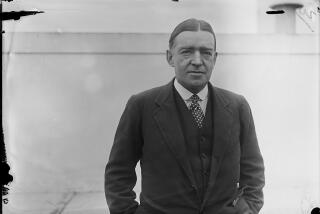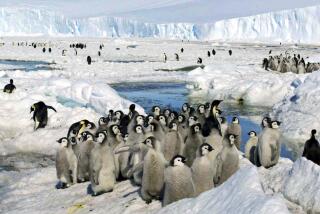Bound for Antarctica: Earth’s Last Frontier
- Share via
KING GEORGE ISLAND, Antarctica — It was 3 a.m. when the travel clock slid across the cabin floor along with various cosmetics.
We had come serenely through Beagle Channel and were going “round the Horn.”
Waves smashed against the portholes. I braced myself in the lower berth against the heavy pitching and rolling of the World Discoverer. Tales of ships lost in these waters, and the flooded hold of the Bounty, came to mind when I noticed that a porthole was leaking.
I wanted to go on deck to see where the Atlantic and Pacific Oceans converge to create the most turbulent water in the world, but my stomach said, “Don’t do it.”
With the Atlantic to port and the Pacific on the starboard, we were heading into Drake Passage bound for Antarctica. Waves driven by the perpetual westerlies were up to 35 feet.
We were running in the troughs and listing as much as 30 degrees, but the sturdy expedition ship, with its hardened hull for navigating in ice-bound waters, did not creak or groan like the wooden vessels in old sea stories.
The next morning a shipmate called, “Black-browed albatross!” alerting us to a great white bird gliding in the ship’s green wake on an 11-foot wingspan.
Resorting to Ear Patch
Brown skuas, spotted cape pigeons and petrels circled the ship. Watching the birds in the brisk air mitigated a threat of mal de mer, but even the hardiest resorted to an ear patch to prevent seasickness before our first day at sea was over.
It’s not easy traveling to the last frontier on Earth. Delays at airports, fog and an overnight stop at Santiago, Chile, added up to more than four tiresome days before we dropped anchor off Wienke Island, site of an abandoned whaling station.
We waded ashore from a rubber dinghy to a place of extraordinary beauty. A glacier that once covered the entire island has receded to the far shoreline, where, warmed by the virtually constant summer sun, massive sheets of ice break off (calving) to form icebergs.
From the west side of the glacier, seven unseen masses cracked loose and plunged into the sea. The sound is, indeed, as Charles Darwin had said, “Like the blast of a man-of-war.” Those distant booms and the raucous calls from a small rookery of penguins are the only sounds that break the silence of the blue-and-white frozen wilderness.
The air was pure, surprisingly warm at 26 degrees Fahrenheit; the sun sparkled on sculptured ice forms floating in an inlet. If it hadn’t been for a small deserted building and bleached whale bones we could have believed that we were the only people to have ever walked on this land.
The penguins greeted us, “Ha! Ha, ha, haruh!” then tucked their woolly gray 3-week-old chicks under their bellies and paid no more attention to us even when we walked within flipper-flapping distance.
Diet of Krill
The gentoos and chinstraps, about 18 inches high, sit on nests of stones spaced two feet apart, just beyond squirting range of their neighbors. Their diet of krill establishes the odor of long-dead fish so pungent that one soon learns to stand upwind.
The intrigues of penguin family life entertained us as we watched a male stealing stones from nests of neighbors who could not leave their chicks to pursue the thief out of fear of skuas flying overhead.
He presented each stone to his mate, who accepted the gift nonchalantly, not seeming to care that he had acquired it despite many a cuff from a leathery flipper that sent him staggering.
Although excellent swimmers, the penguins we saw are surprisingly awkward on land, just barely managing to maintain balance with their spiky tail feathers acting as props to keep them from falling over backward. With flippers extended like fat arms, they present the appearance of tipsy old men coming home from a formal party.
Their fat, pink-webbed feet clutch uncertainly at rocks. They teeter, often stumble and fall. On snow, however, they simply belly-slide.
Hungry Adelie penguins, chinstraps and gentoos came to the sea to feed, but on reaching the water’s edge they stopped, pulled back and milled around, none wanting to be the first one in. As the rocks became crowded, some were pushed in, protesting all the way.
In Feet First
Most went in feet first like small boys jumping into water. One reluctant Adelie kept pulling back, sliding on the slippery rock and at last dived in head first, the only one to take that approach.
They bobbed near the shore till the need to feed their chicks drove them into deeper water where krill swam, providing an abundant protein-rich buffet.
One morning a storm whipped up high seas, postponing a landing at Deception Island. After a day of watching spray from the bow spume over the crow’s nest, conversation turned to “survival” at the bar, where having a cocktail before dinner was a matter of holding onto one’s drink and the bar.
Making it to the dining room, for those who could, required plotting a safe course from handrail to pole to handrail. When a gigantic wave caught us amidships, sending china crashing in the galley, Capt. Heinz Aye announced: “We will maintain our position till dinner is over and the dishes are washed. Then we will seek shelter 10 miles north in the lee of Livingstone Island.”
Timid passengers sought the security of their berths, strapping themselves in, while hardy devotees of sea stories sat on the observation deck and thoroughly enjoyed being frightened by mountainous waves. With confidence in the captain and his ship, we peered out the streaming windows at boiling whitecaps, barely managing to stay in our chairs.
When friends learned that I was going to Antarctica, they exclaimed either, “Wow!” or asked, “Why?”
As we cruised Lemaire Channel, I hoped I could describe for the “wowers” this awesome, fiord-like, towering frozen splendor.
Cliffs of Ice
The sun was obscured behind cliffs of ice and rocky mountain peaks that jutted through fields of blue snow. Icebergs, carved by currents of water, had flipped over, revealing intricate frosty passages and caves. Some as large as the ship drifted by with 900-pound elephant seals sleeping on the frigid verandas.
Creviced glaciers were mirrored in the black water. Without the sun’s warmth, it was cold, narrowly pressed as we were between vertical walls of ice. Then the captain called, “Whales on the starboard bow!”
Antarctica is a continent of surprises: Although the mile- to two-mile-deep ice cap depresses the central part of the land below sea level, it is the driest place on earth, making its atmosphere brilliantly transparent.
For glaciologists, the ice cap is a treasure of information. In it they find successive layers of trapped air bubbles with samples of the climate at the time the snow fell. Layers can be dated by counting down from the surface as with tree rings. A drilled ice core can yield an unbroken record of atmospheric conditions going back before the Roman Empire and includes every nuclear test of the 20th Century.
Volcanic eruptions halfway around the globe are recorded in well-defined strata as were those of nearby Deception, a doughnut-shaped island with a narrow, shallow inlet that leads into a large inner harbor created when a once-mighty mountain blew its top.
Shedding Thermal Underwear
From fissures, sulfuric steam and boiling water still issue. Twenty shipmates shed thermal underwear to put on swimsuits. They splashed through alternate currents of hot and frigid water as the ship’s chief steward waded after them, serving hot mulled wine.
Mindful of the fragile ecosystem, we were meticulously careful wherever we landed, to take only pictures, leave only footsteps. The conservationists among us remembered what Capt. James Cook said after he circumnavigated the continent in 1775: “I make bold to declare that the world will derive no benefit from it.”
We hoped that the only benefit derived from it would be as a future world park, off limits to national and commercial exploitation. It does not seem too much to ask for our last unspoiled wilderness, a truly spectacular place where it is possible to see simultaneously at midnight in January the light of a setting sun off to starboard and the light of the rising sun to port.
Information on Project Antarctica is available from Society Expeditions, 723 Broadway East, Seattle, Wash. 98102, phone (206) 324-9400.
Two ships, World Discoverer and Society Explorer, sail to the Antarctic during the southern summer months of November, December and January. Single cost for double occupancy costs $4,750 to $10,950 for a 15-day cruise. For 22 days, $7,920 to $17,775. Every cabin has an outside view, private bathroom, ample storage and at least two lower berths.
Society Expeditions supplies warm polyester-insulated red parkas, hats, knapsacks and carry-on bags. Experts from ecological disciplines lecture. Temperatures vary from about 20 to 40 degrees. The food is excellent.
For photographers, an ASA rating of 64 is usually sufficient for most ambient light situations. Antarctic sun is deceptively bright, so a polarizing filter is necessary, also plastic bags to protect gear.
More to Read
Sign up for The Wild
We’ll help you find the best places to hike, bike and run, as well as the perfect silent spots for meditation and yoga.
You may occasionally receive promotional content from the Los Angeles Times.






